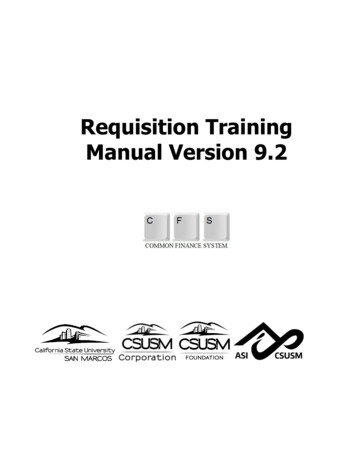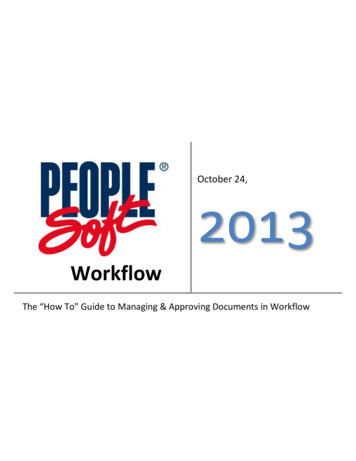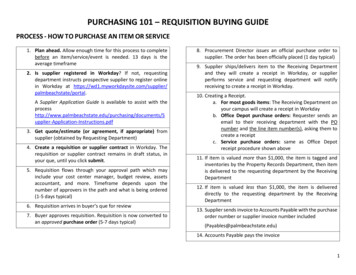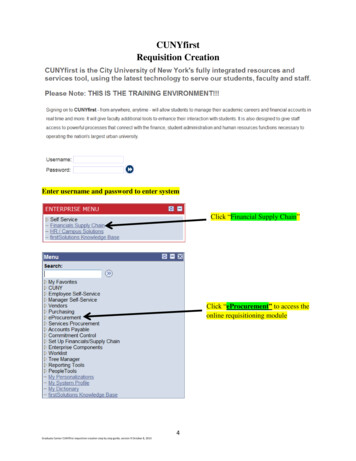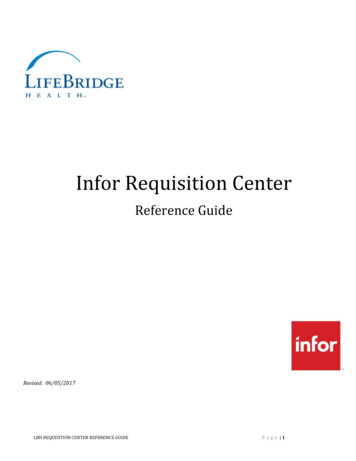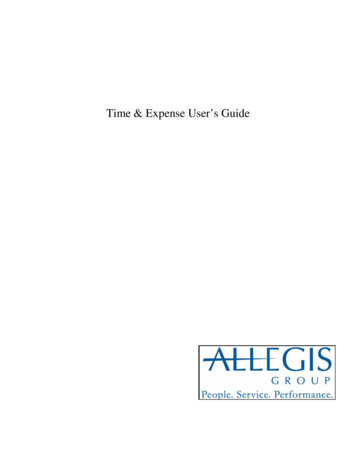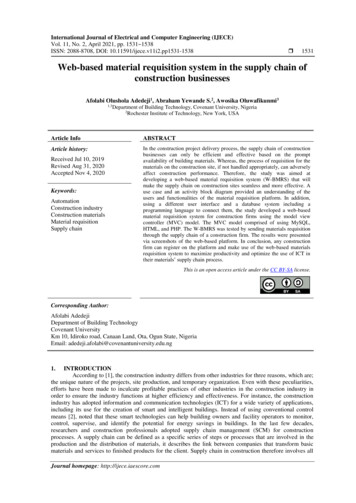
Transcription
International Journal of Electrical and Computer Engineering (IJECE)Vol. 11, No. 2, April 2021, pp. 1531 1538ISSN: 2088-8708, DOI: 10.11591/ijece.v11i2.pp1531-1538 1531Web-based material requisition system in the supply chain ofconstruction businessesAfolabi Olushola Adedeji1, Abraham Yewande S.2, Awosika Oluwafikunmi31,3Departmentof Building Technology, Covenant University, NigeriaInstitute of Technology, New York, USA2RochesterArticle InfoABSTRACTArticle history:In the construction project delivery process, the supply chain of constructionbusinesses can only be efficient and effective based on the promptavailability of building materials. Whereas, the process of requisition for thematerials on the construction site, if not handled appropriately, can adverselyaffect construction performance. Therefore, the study was aimed atdeveloping a web-based material requisition system (W-BMRS) that willmake the supply chain on construction sites seamless and more effective. Ause case and an activity block diagram provided an understanding of theusers and functionalities of the material requisition platform. In addition,using a different user interface and a database system including aprogramming language to connect them, the study developed a web-basedmaterial requisition system for construction firms using the model viewcontroller (MVC) model. The MVC model comprised of using MySQL,HTML, and PHP. The W-BMRS was tested by sending materials requisitionthrough the supply chain of a construction firm. The results were presentedvia screenshots of the web-based platform. In conclusion, any constructionfirm can register on the platform and make use of the web-based materialsrequisition system to maximize productivity and optimize the use of ICT intheir materials’ supply chain process.Received Jul 10, 2019Revised Aug 31, 2020Accepted Nov 4, 2020Keywords:AutomationConstruction industryConstruction materialsMaterial requisitionSupply chainThis is an open access article under the CC BY-SA license.Corresponding Author:Afolabi AdedejiDepartment of Building TechnologyCovenant UniversityKm 10, Idiroko road, Canaan Land, Ota, Ogun State, NigeriaEmail: CTIONAccording to [1], the construction industry differs from other industries for three reasons, which are;the unique nature of the projects, site production, and temporary organization. Even with these peculiarities,efforts have been made to inculcate profitable practices of other industries in the construction industry inorder to ensure the industry functions at higher efficiency and effectiveness. For instance, the constructionindustry has adopted information and communication technologies (ICT) for a wide variety of applications,including its use for the creation of smart and intelligent buildings. Instead of using conventional controlmeans [2], noted that these smart technologies can help building owners and facility operators to monitor,control, supervise, and identify the potential for energy savings in buildings. In the last few decades,researchers and construction professionals adopted supply chain management (SCM) for constructionprocesses. A supply chain can be defined as a specific series of steps or processes that are involved in theproduction and the distribution of materials, it describes the link between companies that transform basicmaterials and services to finished products for the client. Supply chain in construction therefore involves allJournal homepage: http://ijece.iaescore.com
1532 ISSN: 2088-8708construction companies, whether they are functioning as the designer, main contractor, surveyor, subcontractor, supplier, or the client. The supply chain of construction firms is divided into several segmentswhich ensure the delivery of building materials to the construction site.From ordering materials needed to contacting the supplier and final installation, each of theseactivities are critical and form an essential part of the construction process. One crucial aspect of the supplychain in the construction process is when materials are needed and a requisition order is to be instituted. Arequisition is a listing of materials needed for a project which is filled out on the construction site and sent tothe head office, before being sent to the supplier, it contains details of the materials needed and the dates onwhich they are needed. The requisition ultimately leads to the procurement phase and determines the supplyof materials. Most times, on construction sites in Nigeria, a material requisition form is raised in order for thebuilding materials to be supplied to the site. A materials requisition form in the construction industry is asource document used to request for materials used in the construction process. The materials requisitionprocess can be divided into two parts, the first is a requisition made by the supervisor on site, this is sent tothe head office of the construction company, the second part is sent from the head office to the supplier. Theprocess of materials requisition stops when it reaches the supplier, after which the supply is made.The problem with the material requisition process in Nigeria is that a large number of constructioncompanies still carry out paper-based materials requisition, including the manual documentation of all thetransactions carried out. This article aims to address this issue by introducing the use of ICT for materialrequisitions. Small construction companies, may not even have any mode of documentation, or have aspecific process set aside for materials requisition, this means that there is no way of effectively following uprequisitions. In Nigeria, building materials requisition are sometimes done via phone calls and word-ofmouth mechanisms which hampers the accountability, traceability, and sustainability of the process. Thereare lots of problems associated with not having proper record keeping and inventory of material supply chainin the management of construction sites [3, 4]. Even for the paper-based methods, several changes have beenattributed to its use for material recording. The use of a web-based system for materials requisition willensure an easier and a more effective process, this way, the process can be followed and tracked from therequisition phase to the supply phase, with proper documentation for referencing. Integrating ICT in thematerials requisition process is expected to reduce the possibility of fraud, and increase accountability onconstruction projects, therefore benefiting professionals involved in construction projects, and theconstruction industry at large. In this light, the study intends to develop a web-based material requisitionsystem in a construction supply chain.2.REVIEW OF RELATED LITERATUREMany industries are becoming automated due to its efficiency and effectiveness in terms of speed,cost, quality, innovation, and customer satisfaction. Some sectors that have witnessed the use of automationinclude the power sector [5], education sector [6] and manufacturing sector [7]. The construction industryuses construction project management systems these systems can be developed in-house solely for companyuse [8]. For the construction industry, one of its activities that is in dire need for automation is the materialmanagement process. The material management process on construction sites can be divided into differentphases. The study by [9] stated that material management is the business aspect of construction activities thatdeal with material planning, procurement, delivery, handling, storage, and releasing the material for use onthe construction sites. For material management to be effective and efficient there is a need for a seamless supplychain. The use of ICT in the supply chain is not new and innovative technologies are being developed. Kasim [10]pointed out the use of bar coding and scanners, electronic data interchange (EDI), enterprise-wideinformation systems such as the use of enterprise resource planning (ERP) systems, radio frequencyidentification (RFID) and passive tags, e-commerce platforms and other web services. In the latter, previousstudies have shown the use of web- based apps in the use of material supply in the procurement process ofconstruction businesses [11]. The study utilized image processing sensors (IPS) and geographic informationsystems (GIS) to develop the web-based app to monitor material wastage in the supply chain process.Construction supply chain management (CSCM) was integrated with BIM and GIS [12]. Through this study,a decision support framework was developed to improve the efficiency of the supply chain in construction.In Kulkarni [13] tracked different steps in the procurement process and created a decision makingframework to assist in the determination of the order quantity and the reorder point. The need of acommercial information exchange in architecture, engineering and construction (AEC) supply chain firmswas discussed [14]. The key factors that should be considered in these systems for implementation includetechnical, coordination, integration and organizational factors [14]. Koriom et al. [15] also consideredcommercial information exchange and e-trading solutions in construction. Examined studies that have lookedinto materials management and indicated that large construction contractors are applying materialsInt J Elec & Comp Eng, Vol. 11, No. 2, April 2021 : 1531 - 1538
Int J Elec & Comp EngISSN: 2088-8708 1533management in their projects but there is a need for more studies considering small and medium contractingfirms. Although, not specifically focused on the construction industry, Madhusudan and Rao [16]differentiated between an e-procurement system and a platform for making online purchases. They found thatthere was insufficient research in cloud-based e-procurement platform and mentioned the need to followappropriate standards in the development of this system. Cardoso and Biazzin [17] considered the benefits ofe-procurement to maintenance, repairs and operations suppliers. In Deraman et al. [18] developed anelectronic purchasing (e-procurement) framework for construction also indicating that these systems havesometimes failed. According to [18], procurement policy, employee commitment, project milestones, changemanagement, stakeholder involvement and project planning influence the decision to implement an eprocurement framework in the construction industry. Amade et al. [19] indicated that the most importantfactors for successful supply chain management was relationship among supply chain partners, supply chainfinancing and supply chain and continuous performance measurements. These studies have shown that avariety of factors should be included in the development of a SCM system.In the study by [4], an IT framework was integrated with construction material planning andcontrolling system, whereby the proposed web-based system can prompt construction professionals on theshortfall of building materials on the construction site before a construction activity is carried out. However,the study did not link the construction material supplier into the loop in order to aid the supply of the neededbuilding material. Whereas, this study aims to complete the loop from the point of need to the head office ofthe construction firm to the supplier and back to the construction site where the building material is needed.A close description of a web-based application in the supply chain of firms was developed in [20]. In [20],the web-based app was designed for a manufacturing business firm. In this web-based application, asdescribed in [20], customers log on the web browser of the manufacturing firm (suppliers) and make arequest for deliveries of their products. The web-based application in the supply chain then moves to selectraw materials, produce and state the delivery time to the customer while also getting the customer feedback.It is worthy to note that the manufacturing sector differs from the construction industry in so many ways.Building materials in the construction industry are finished products making it easier to estimate, quantifyand ready for delivery at any time. Unlike in [20], this study added the layer of the head office as an oversiteand for approval of what is needed on each construction site before forwarding the request to the mostqualified building materials’ supplier. In simpler terms, some construction businesses use emails for theirconstruction material requisition in the supply chain of their firms. The study by [21] noted that emails hadbecome an integral part of most organizations by providing essential communication and collaborationchannels. Lucas [22] argued that the important key in the use of emails is the informal knowledge flowamong the firm’s workers. However, the use of emails cuts across different activities on construction sites,thereby, encouraging the inability to filter correspondence on only building materials needed per site. Thisstudy suggested the need to have a concentrated platform specifically for building materials supply chain inconstruction businesses.3.RESEARCH METHODOLOGYThe study designed a web-based system for material requisition to aid the supply chain managementprocess. A model view controller (MVC) pattern of programming was used in developing the automatedsystem as used in previous studies [4, 20, 23, 24]. The automated system required a transactional databasewhereby the users can input data in the empty tables as the model. My structured query language (MySQL)was used as the real-time open source database system used to design the model. The study utilized a webbased interface as the view, which was designed using hypertext markup language (HTML) and thecommunication (controller) within the database was achieved using hypertext pre-processor (PHP)programming language. PHP is a highly used open-source technology, mostly suitable for web developmentand is usually embedded within HTML. PHP being an open-source software requires no licensing fees, henceit is cheaper to deploy than other server-side languages. In order to understand the web-pages to be designedand the functionalities required in the web-based material requisition, a use case diagram and an activitydiagram were developed as shown in Figure 1 and Figure 2 respectively. The use case diagram and theactivity block diagram were used to design the web-based system, which is accessible via the igure 1 shows the three primary users of the system in the supply chain process of materialrequisition. The process starts from the construction site where the materials are needed, to the head officewhere it is forwarded to the building materials’ supplier. The activity block diagram for the materialrequisition platform shows how the different users will interact with the system.Web-based material requisition system in the supply chain of construction businesses (Afolabi Adedeji)
1534 ISSN: 2088-8708Figure 1. Use case diagram for the material requisition platformFigure 2. Activity block diagram for the material requisition platform4.SYSTEM IMPLEMENTATIONIn order to show the system implementation of the automated building material requisition platformfor use by construction firms, the result was presented using screenshots. Figures 3 to 10 present the screenshots of the web-pages of the material requisition web-based system. The home page of the materialrequisition is presented in Figure 3. From the home page, users are able to click on their respective roles inthe material requisition process.Figure 4 presents the registration page for the head office and the suppliers. The head office and thesuppliers need to register their companies on the web-based material requisition page in order to use thesystem. In this registration page, users enter their personal information and also provide an email address andpassword which will be used to login to the system.Figure 3. Home page of the web-based material requisition platformInt J Elec & Comp Eng, Vol. 11, No. 2, April 2021 : 1531 - 1538
Int J Elec & Comp EngISSN: 2088-8708 1535Figure 4. Registration as head office/supplierFor onsite construction personnel to access the material requisition web-based system, they need tobe added to the system, as shown in Figure 5. Essentially, the email and password of the onsite constructionpersonnel are created for the personnel by the head office in the system. Once all the users have their emailsand password adequately registered on the platform, they can adequately login on the platform, as shown inFigure 6.Figure 5. “Add onsite construction personnel” interface by head officeFigure 6. Login page in material requisition processWeb-based material requisition system in the supply chain of construction businesses (Afolabi Adedeji)
1536 ISSN: 2088-8708In Figure 7, onsite construction personnel are able request the building materials as needed on theconstruction site. The name of the project, the location, the item needed and the expected delivery date iscommunicated to the head office via the material requisition platform. Figures 8 and 9 presents the view ofthe dashboard from the head office. The head office is able to view the material request needs for all theconstruction sites that the company operates and forward the request to suppliers that have registered with thecompany and registered on the platform. Figure 10 includes the dashboard for the supplier. The supplier can viewthe material request forwarded from the construction company and take action for the delivery of the material.Figure 7. Request page from the construction site to the head officeFigure 8. Dashboard of material request view at head officeFigure 9. Forwarding of the material request from head office to the supplierInt J Elec & Comp Eng, Vol. 11, No. 2, April 2021 : 1531 - 1538
Int J Elec & Comp EngISSN: 2088-8708 1537Figure 10. Materials’ supplier dashboard to view materials’ requestThe web-based material requisition system has been tested using a construction firm’s constructionactivities as the basis. These are the results presented in the screenshot in Figures 3 to 10. In comparison ofthis web-based system to others in previous studies in [4, 11, 20, 25, 26], this study focused on the requisitionof building materials on construction sites. The result achieved in this web-based material requisition systemis that material requisition has been simplified and digitalized compared to the paper-based methods. Otherstudies had focused on the manufacturing sector and e-commerce platforms, but this study has specificallydeveloped a web-based app for the construction industry. The material request moves from the constructionsite to the head office to the suppliers’ platform. This study opines that when construction businesses adoptthis web-based system for material requisition, they will be able to move from the traditional mode of paperbased requisition to a paperless requisition platform. In addition, this would aid proper record keeping andretrieval of information on material requisition. However, in using this web-based material requisitionplatform, all the users need a smartphone or laptop connected to the internet to access the services on theplatform. Meaning that construction businesses need to invest in ICT infrastructure that support the web-basedsystem and other suppliers that are not connected may be disenfranchised from the material requisition process.5.CONCLUSIONThe study aimed to develop a web-based material requisition system that will make the supply chainon construction sites seamless and more effective. Through the drafting of a use case diagram and an activityblock diagram, the three (3) primary users of onsite construction personnel, head office, and materials’suppliers including functionalities of the material requisition platform were detailed. In addition, using adifferent user interface and a database system, including a programming language to connect them, the studydeveloped an automated web-based material requisition system for construction firms using the MVC model.The MVC model comprised of using MySQL, HTML and PHP respectively in the design. The automatedmaterials requisition system was tested by sending material requisition through the supply chain of aconstruction firm. The results of the web-based system were presented via screenshots of the materialrequisition platform. Different web-based interfaces such as the homepage, registration pages, onsite materialrequisition pages, forwarding of requisition to supplier pages were created. In conclusion, any constructionfirm can register on the platform and make use of the web-based material requisition system to maximize theproductivity and optimize the use of ICT in their materials’ supply chain process. Future work will include anevaluation of the system with construction professionals and suppliers to assess the effectiveness of thissystem and gather feedback on improvements. The study recommended the use of web-based systems in toensure speed, accountability and sustainability of construction processes.ACKNOWLEDGEMENTSThe authors appreciate the financial contribution of Covenant University Centre for Research,Innovation and Discovery towards the Open Access to the content of this article.Web-based material requisition system in the supply chain of construction businesses (Afolabi Adedeji)
1538 ISSN: 3][24][25][26]M. B. Ali, Y. G. Yazed, A. B. Ayman, “Institutional smart buildings energy audit,” International Journal ofElectrical and Computer Engineering (IJECE), vol. 9, no. 2, pp. 783-788, 2019.V. C. Durai and K. Sentamilselvan, “A study on supply chain frame work in construction Industry,” InternationalJournal of Research, vol. 4, no. 8, pp. 16-26, 2016.A. Afolabi, et al., “Critical Success Factors (CSFs) for e-Procurement Adoption in the Nigerian ConstructionIndustry,” Buildings, vol. 9, no. 47, pp. 1-18, 2019.A. Afolabi, et al., “IT Management of Building Materials’ Planning and Control processes using Web-BasedTechnologies,” World Conference on Information Systems and Technologies WorldCIST 2017, vol. 570, pp. 12-19, 2017.A. Ademola, T. E. Somefun, A. F. Agbetuyi, A. Olufayo, “Web based fingerprint roll call attendance managementsystem,” International Journal of Electrical and Computer Engineering (IJECE), vol. 9, no. 5, pp. 4364-4371, 2019.Y. N. Doddaman, U. C. Kapale, “A transition from manual to intelligent automated power system operation-a indicativereview,” International Journal of Electrical and Computer Engineering (IJECE), vol. 9, no. 4, pp. 2274-2280, 2019.F. Fareeza, C. Rambabu, S. Krishnaveni, A. C. Kabiso, “Automation of DMPS Manufacturing by Using LabViewand PLC,” International Journal of Electrical and Computer Engineering (IJECE), vol. 8, no. 6, pp. 5484-5494, 2018.P. Nitithamyong and M. Skibniewski, "Web-based construction project management systems: how to make themsuccessful?," Automation in Construction, vol. 13, no. 4, pp. 491-506, 2004.E. E. Ogbadu, “Profitability through effective management of materials,” Journal of economics and InternationalFinance, vol. 1, no. 4, pp. 99-105, 2009.N. Kasim, “Improving materials management practices in construction projects,” International Symposium inDeveloping Economies: Commonalities among Diversities, pp. 356-369, 2011.A. Ahad, Z. R. Khan, S. Srivastava, “Application of IT in Supply of Construction Material Procurement,”International Journal for Science and Advance Research in Technology, vol. 3, no. 7, pp. 638-642, 2017.Y. Deng, V. Gan, M. Das, J. Cheng and C. Anumba, "Integrating 4D BIM and GIS for Construction Supply ChainManagement," Journal of Construction Engineering and Management, vol. 145, no. 4, p. 04019016, 2019.A. Kulkarni and S. Halder, "A simulation-based decision-making framework for construction supply chainmanagement (SCM)," Asian Journal of Civil Engineering, vol. 21, no. 2, pp. 229-241, 2019.M. Pala, F. Edum-Fotwe, K. Ruikar, C. Peters and N. Doughty, "Implementing commercial information exchange:a construction supply chain case study," Construction Management and Economics, vol. 34, no. 12, pp. 898-918, 2016.N. Koriom, J. Brahim, I. Zakaria, A. Kaish and M. Mohsen, "The State of the Art of Materials ManagementResearch in the Construction Industry," MATEC Web of Conferences, vol. 266, p. 05013, 2019, pp. 1-6.N. Madhusudan and L. Rao, "Insights on Extent of Effectiveness, Trend, and Gap in Existing Frameworks for eProcurement System," International Journal of Electrical and Computer Engineering (IJECE), vol. 6, no. 2,pp. 751-758, 2016.A. Cardoso and C. Biazzin, "What is the value of e-procurement for suppliers The drivers, barriers andopportunities for engaging MRO suppliers," International Journal of Procurement Management, vol. 13, no. 2,pp. 278-298, 2020.R. Deraman, C. Wang, J. Yap, H. Li and F. Mohd-Rahim, "Developing Internet Online Procurement Frameworksfor Construction Firms," Future Internet, vol. 11, no. 6, p. 136, 2019.B. Amade, E. O. P. Akpan, U. F. Amaeshi, K. A. Okorocha and A. C., Ogbonna, “Delineating supply chainmanagement (SCM) features in construction project delivery: The Nigerian case,” International Journal ofConstruction Supply Chain Management, vol. 7, no. 1, pp. 1-19, 2017.K. C. Kodali, "Development of Web Based Application for Supply Chain Management,” Culminating Projects inMechanical and Manufacturing Engineering, vol. 60, pp. 1-56, 2016.D. Derks and A. B. Bakker, “The Impact of E-mail Communication on Organizational Life,” Cyberpsychology:Journal of Psychosocial Research on Cyberspace, vol. 4, no. 1, pp. 1–6, 2010.W. Lucas, “Effects of E-Mail on the Organization,” European Management Journal, vol. 16, no. 1, pp. 18-30, 1998.A. Afolabi, et al., “Construction Professionals’ Perception of a Web-Based Recruiting System for Skilled Labour,”Journal of Theoretical and Applied Information Technology, vol. 96, no. 10, pp. 2885-2899, 2018.A. Afolabi, et al., “Development of a Web-Based Tendering Protocol for Procurement of Construction Works in aTertiary Institution,” Journal of Theoretical and Applied Information Technology, vol. 95, no. 8, pp. 1595-1606, 2017.B. H. Solanke and J. A. Fapohunda, “Impacts of E-Commerce on Construction Materials Procurement forSustainable Construction,” World Congress on Sustainable Technologies, 2015, pp. 65–70.B. Omar and T. Ballal, “Intelligent wireless web services: context-aware computing in construction-logistics supplychain,” Journal of Information Technology in Construction, vol. 14, pp. 289–308, 2009.Int J Elec & Comp Eng, Vol. 11, No. 2, April 2021 : 1531 - 1538
source document used to request for materials used in the construction process. The materials requisition process can be divided into two parts, the first is a requisition made by the supervisor on site, this is sent to the head office of the construction company, the second part is sent from the head office to the supplier. The
